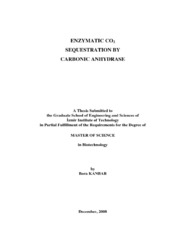Please use this identifier to cite or link to this item:
https://hdl.handle.net/11147/3957Full metadata record
| DC Field | Value | Language |
|---|---|---|
| dc.contributor.advisor | Özdemir, Ekrem | - |
| dc.contributor.author | Kanbar, Bora | - |
| dc.date.accessioned | 2014-07-22T13:52:49Z | - |
| dc.date.available | 2014-07-22T13:52:49Z | - |
| dc.date.issued | 2008 | - |
| dc.identifier.uri | http://hdl.handle.net/11147/3957 | - |
| dc.description | Thesis (Master)--Izmir Institute of Technology, Biotechnology, Izmir, 2008 | en_US |
| dc.description | Includes bibliographical references (leaves: 101-104) | en_US |
| dc.description | Text in English; Abstract: Turkish and English | en_US |
| dc.description | x,55 leaves | en_US |
| dc.description.abstract | Carbonic Anhydrase (CA) was immobilized within Polyurethane (PU) Foam and characterized for CO2 sequestration purposes. The catalytic activities for the free and immobilized CA were estimated by using p-Nitrophenyl Acetate (p-NPA) as the substrate. The activities were estimated in tris buffer containing 10% Acetonitrile.Because, the p-NPA is only soluble up to 4mM in aqueous phase. Lineweaver-Burk relationship was employed to estimate the Michaelis-Menten kinetic parameters for the free and immobilized CA. The kcat, KM, and kcat/KM values for free enzyme were found to be 1.21s-1, 12.2mM, and 148.1M-1s-1, respectively. The KM value for immobilized BCA was estimated to be 9.59mM in tris buffer (50mM, pH.7.5), in the presence of 10% acetonitrile at the same conditions. The immobilized CA was stable and did not loose any activity over seven consecutive washings and activity tests. In addition, while the free CA lost its activity in 45 days stored at 4oC in fridge, the immobilized CA was stable and did not loose any activity over 45 day period. The optimum temperature for the immobilized BCA was found to be between 35oC and 45oC. No activity was observed for the immobilized CA at 60oC. Thermal deactivation energies for the free and immobilized CA were found to be 29kcal/mol and 86kcal/mol, respectively. The immobilized CA was employed in CaCO3 precipitation. It was found that the CaCO3 particles were less than 100nm and more evenly dispersed. It was concluded that the immobilized CA could be used in CO2 sequestration. | en_US |
| dc.language.iso | en | en_US |
| dc.publisher | Izmir Institute of Technology | en_US |
| dc.rights | info:eu-repo/semantics/openAccess | en_US |
| dc.subject.lcc | QD181.C1 K1618 2008 | en |
| dc.subject.lcsh | Carbon dioxide | en |
| dc.subject.lcsh | Carbon anhydrase | en |
| dc.title | Enztmatic Co2 Sequestration by Carbonic Anhydrase | en_US |
| dc.type | Master Thesis | en_US |
| dc.institutionauthor | Kanbar, Bora | - |
| dc.department | Thesis (Master)--İzmir Institute of Technology, Bioengineering | en_US |
| dc.relation.publicationcategory | Tez | en_US |
| dc.identifier.wosquality | N/A | - |
| dc.identifier.scopusquality | N/A | - |
| item.openairetype | Master Thesis | - |
| item.languageiso639-1 | en | - |
| item.openairecristype | http://purl.org/coar/resource_type/c_18cf | - |
| item.fulltext | With Fulltext | - |
| item.cerifentitytype | Publications | - |
| item.grantfulltext | open | - |
| Appears in Collections: | Master Degree / Yüksek Lisans Tezleri | |
Files in This Item:
| File | Description | Size | Format | |
|---|---|---|---|---|
| T000767.pdf | MasterThesis | 2.37 MB | Adobe PDF |  View/Open |
CORE Recommender
Page view(s)
212
checked on Jul 14, 2025
Download(s)
188
checked on Jul 14, 2025
Google ScholarTM
Check
Items in GCRIS Repository are protected by copyright, with all rights reserved, unless otherwise indicated.